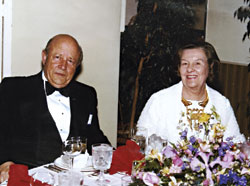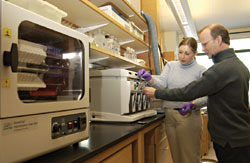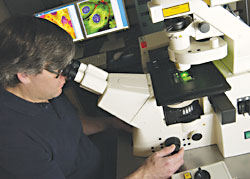Development
Dartmouth-Hitchcock Medical Center Development
Keeping an eye on the future
By Barbra Alan
In his ophthalmology practice, Dr. Clarence Albaugh, a 1934 alumnus of Dartmouth Medical School, often used a binocular ophthalmo-scope— a device that provides a stereoscopic view of the interior of the eye. As a talented filmmaker, Albaugh used a 16-millimeter movie camera to record his adventures traveling all over. And as an amateur ham radio enthusiast, he used a two-way radio to communicate with other ham operators throughout the country and around the world.
Whether it was in his beloved profession or in pursuing his numerous hobbies, the late Dr. Albaugh knew how critical the right equipment was to any endeavor. So it's only natural that when he, together with his wife, Estelle Albaugh, decided to honor his alma mater with a $1-million bequest, they chose to have it go toward the purchase of equipment for medical research.
A lifetime of giving
A generous philanthropist, Dr. Albaugh strongly believed in "giving back" to the schools that he'd attended. He felt that these institutions had helped him to become a successful physician.
But the road to success got off to a bumpy start for young Clarence. He had barely entered Dartmouth when the stock market crash of 1929 and the ensuing Great Depression decimated his family's finances. To continue his education, "Albie"—as he was known in his Dartmouth days— worked odd jobs during the school year and spent his summers working in Alaska for a relative who was in the fishing industry.
One summer, when business was slow, the young medical student seized the opportunity to put his learning into practice and at the same time serve the rural Alaska community where he was working. In a March 1932 letter to Dr. Rolf Syvertsen, one of his favorite professors at DMS, "Albie" explained, "The season here has been rotten as far as fish-buying is concerned. The fishermen are on strike, and until the strike ends I am nothing but a glorified storekeeper. However, the medical business is thriving. There is no doctor within about 75 miles, so I'm having plenty to do in the line of cuts and sick babies."
It was during these summers in Alaska that Albaugh also developed two lifelong passions: operating ham radios and flying small aircraft. Both were essential to life in rural Alaska in the 1930s: the radios for communication, and the planes for quick and easy transportation.
After finishing his training, Albaugh headed for California and opened his own ophthalmology practice in Los Angeles—a practice he eventually shared with his younger sister, Katherine, who followed in her brother's footsteps and became an ophthalmologist, too.
For over four decades, Clarence Albaugh maintained a busy practice and served on the staff of several Los Angeles-area hospitals, including Hollywood Presbyterian Hospital (where he was president of the medical staff in 1970 and 1972), Children's Hospital, and Good Samaritan Hospital. He also had faculty appointments at both the University of California at Los Angeles and the University of Southern California. And when his schedule allowed, he and his wife traveled all over the world and filmed their adventures.
Throughout his long and distinguished career, Clarence Albaugh honored his DMS roots by making regular contributions to the DMS Annual Fund, as well as larger capital gifts to support the growth of DHMC. After his death in 1993, Estelle Albaugh continued the tradition of giving to DMS.
|
It was after her death in November 2002 that their ultimate gift— and most meaningful legacy—was bestowed on DMS. John Dundas, trustee of the Albaugh Trust as well as a longtime friend of Clarence's and a fellow ham operator, directed the Albaughs' $1-million gift toward the purchase of cancer research equipment. As Dundas explains, "Both Mrs. Albaugh and Dr. Albaugh's sister, Dr. Katherine Albaugh, died of cancer. Directing this gift specifically for advancing cancer research is most appropriate."
High-tech research
Research has been at the heart of the tremendous advances in cancer survival in recent years. The sequencing of the human genome in 1999 created an exciting new era in cancer research. With the recent expansion of DHMC's Barbara E. Rubin Building, including two new floors of laboratories, plus gifts such as the Albaughs', which will help equip these laboratories, Dartmouth's Norris Cotton Cancer Center is now in a stronger position than ever to recruit and retain the most talented and distinguished scientists and clinicians to lead the way into the next exciting era in cancer research.
"It takes about $100,000 to $200,000 just to get a laboratory up and running—and that's just the mundane items like pipettes, centrifuges, and incubators," explains Dr. Alan Eastman, a professor of pharmacology and toxicology and the associate director for shared resources at the Cancer Center.

|
|
Above: The
late Clarence and Estelle
Albaugh. Below:
some Shared Resource
technologies like those that
were funded by a $1-million
bequest from the Albaughs.
Microarray technician
Anna Forsman and Dr. Alan
Eastman insert a chip with
probes for 22,000 genes into
a fluidics station. Imaging supervisor Kenneth
Orndorff uses a confocal
microscope to analyze cells. |

|

|
Even more costly is the sophisticated technology that advanced cancer research demands. For example, a microarray scanner—which analyzes the expression of tens of thousands of genes simultaneously and is an essential piece of equipment in a cancer research laboratory—costs $150,000. A micro PET scanner— which allows researchers to observe the aftermath of gene mutations or other experimental manipulations in small-animal models—can cost anywhere from $300,000 to $700,000, depending on the size of the unit. Because grants do not generally cover the cost of such equipment, the burden of purchase is on the investigators. But "no single investigator can afford a half-million-dollar piece of equipment," Eastman says.
Because these sophisticated machines are prohibitively expensive for individual investigators—and even entire departments—to buy, the Cancer Center has developed a concept called Shared Resources. By housing such equipment centrally, it is available to the entire research community at Dartmouth, not just a single investigator or department.
Centralized services
Shared Resources saves Dartmouth money as well as something even more precious—time. It is not always practical, or necessary, for all investigators to be trained to use this kind of equipment. At DHMC, professional staff are trained to run and maintain the shared-resource technologies in the most efficient and cost-effective way, providing researchers with the information they need in a timely fashion. By having these technical and intellectual resources readily available to investigators in a centralized location, a lab can quickly acquire the information it needs and move on to its next research objective.
So the foresight and generosity of Clarence and Estelle Albaugh will not only enhance the research efforts of Dartmouth's cancer investigators, it will enhance research performed throughout the entire Dartmouth scientific community.
Barbra Alan is assistant director of development communications at DHMC.
I just want to leave the world a little better than I found
it, and that's my goal in life.
— Entrepreneur and philanthropist Armand Hammer
Making a difference
Whether philanthropic gifts come from individuals—like Clarence and Estelle Albaugh—or from a group—like the Friends of Norris Cotton Cancer Center—they play a vital role in the advancement of cancer research at DHMC.
The Friends of the Norris Cotton Cancer Center was established in 1981 quite literally by friends of the late Senator Norris Cotton, who helped obtain federal funding for the Cancer Center in 1972. Since its founding, the group has raised more than $2 million for NCCC through private contributions, special events, and community projects.
"Our mission is to help the Cancer Center in any way we can," says Friends President Marty Van Oot. "We raise money for research and equipment, promote community education, volunteer time, and work to enhance the patient experience."
The Audrey Prouty Century Ride and Fitness Walk is one of the Friends' most successful fund-raisers. For 23 years, this annual event has united the community in the fight against cancer. In 2003, 1,200 participants and volunteers helped to raise more than $270,000 for research at NCCC.
Other annual Friends events include the Latchkey Ice Race, an exciting stock car race on ice, and the hilarious Circus Smirkus, a fun summer event that raises funds for pediatric oncology.
"Norris Cotton Cancer Center is one of our region's most important resources," concludes Van Oot. "It's an honor to support a world-class institution that happens to be in our own backyard. The Friends and its members are certain that everything we do for the Cancer Center brings us closer to finding a cure. That's what I call making a difference."
